Bouldering
Bouldering is the least demanding discipline of sport climbing concerning equipment and technical skills. Starting with bouldering is the easiest way into the world of climbing activities. For climbing you need only climbing shoes, suitable clothes and magnesium against hands sweating. Then you need a boulder mat for outdoor bouldering and brushes for cleaning holds. Although the climbing is low above the ground, it is necessary to be spottedd by one or two colleagues. The falling climber should be caught on the hips level and his/her fall should be controlled to the ground. You should not let the climber fall on his/her back or head.
Evaluation of a boulder difficulty
Evaluation of performance in bouldering and in climbing generally is very subjective. The ascent difficulty is suggested by the first ascender according to local habits and the difficulty is then adjusted after the discussion with other climbers. In bouldering, there are two classification grades - Fontainebleau grade and Hueco or Sherman V – grade. Their comparison is shown in the table below. Fontainebleau grade is mainly used at the European continent, Hueco grade is used in English speaking countries.
The ascent difficulty is described in guides, or straight at the starting hold of the boulder problem. In many areas there are used arrows for marking the start and direction of the boulder problem. If the arrow has an upright line, you should start with hands under the arrow, if it does not have the upright line, you can start with hands wherever you want
The comparing table of boulder ascents in the Hueco scale and Fontainebleau scale

Grips
In climbing we use several basic grips. Knowledge of grips will improve our climbing movement repertoire a lot. According to the grip direction we distinguish a positive grip, a sidepull and an undercut. According to the finger position we distinguish a crimp and an open grip. In the crimp grip the last two finger parts are in hyperextension and tendon pulleys are overloaded. The open grip is from the biomechanical viewpoint better and should be preferred. Other grip types are depended on hold types.
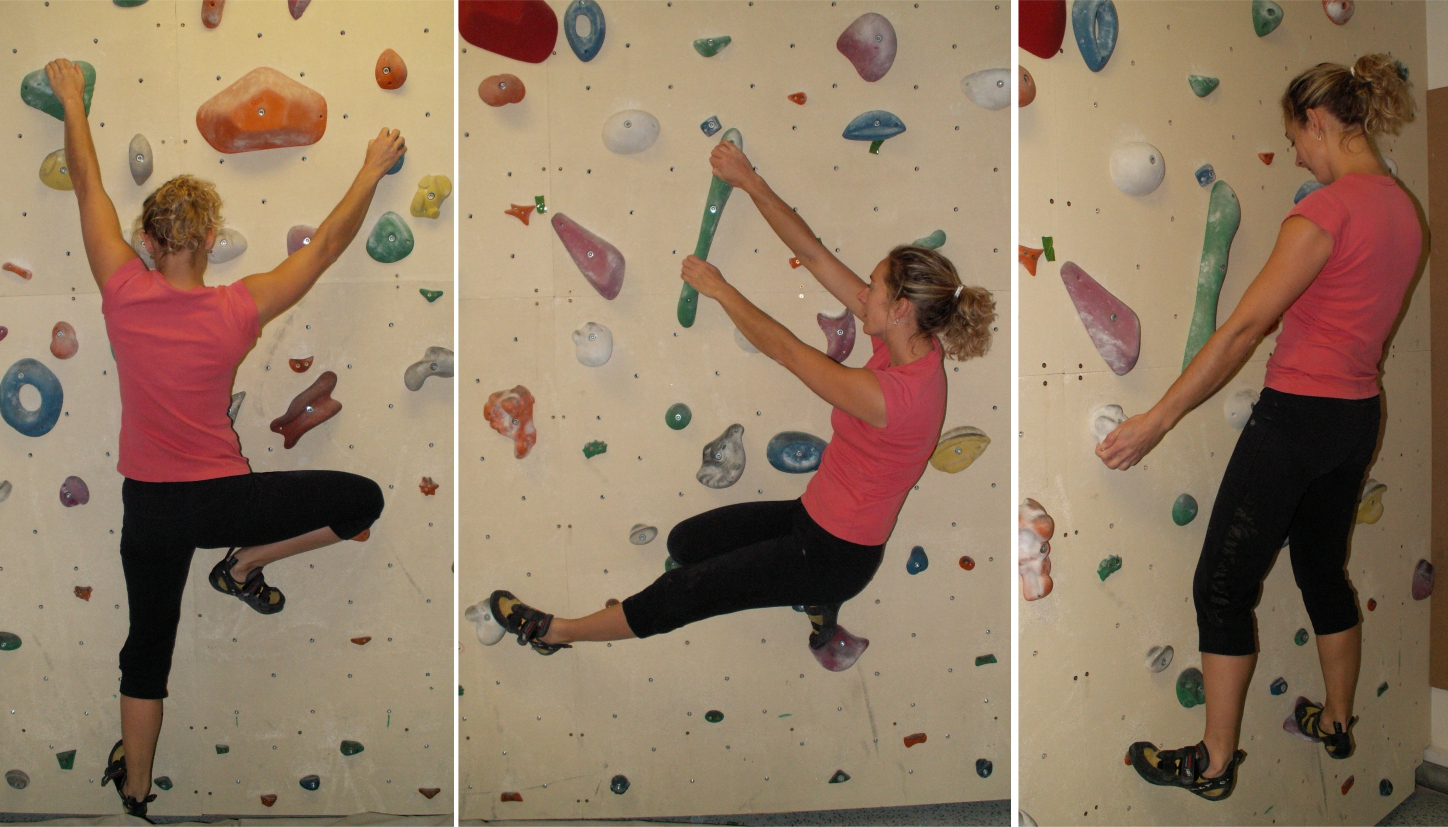
Positive hold - sidepull - undercut
Ledge – a small sharp hold, which tends to the crimp grip.
Sloper – rounded hold which is advantageous to hold with the greatest finger area and palm.
Pocket – a hole for two up to four fingers, a demanding grip for finger flexors strength
Little hole - a hole for one or two fingers, a very good strength of finger flexors is needed
“Hand jam“– a specific grip for crack climbing, when jamming finger and palm in a crack by a small rotation of the wrist and putting the thumb under the palm
Pinch grip - the only grip in climbing when the thumb is in opposition to other fingers
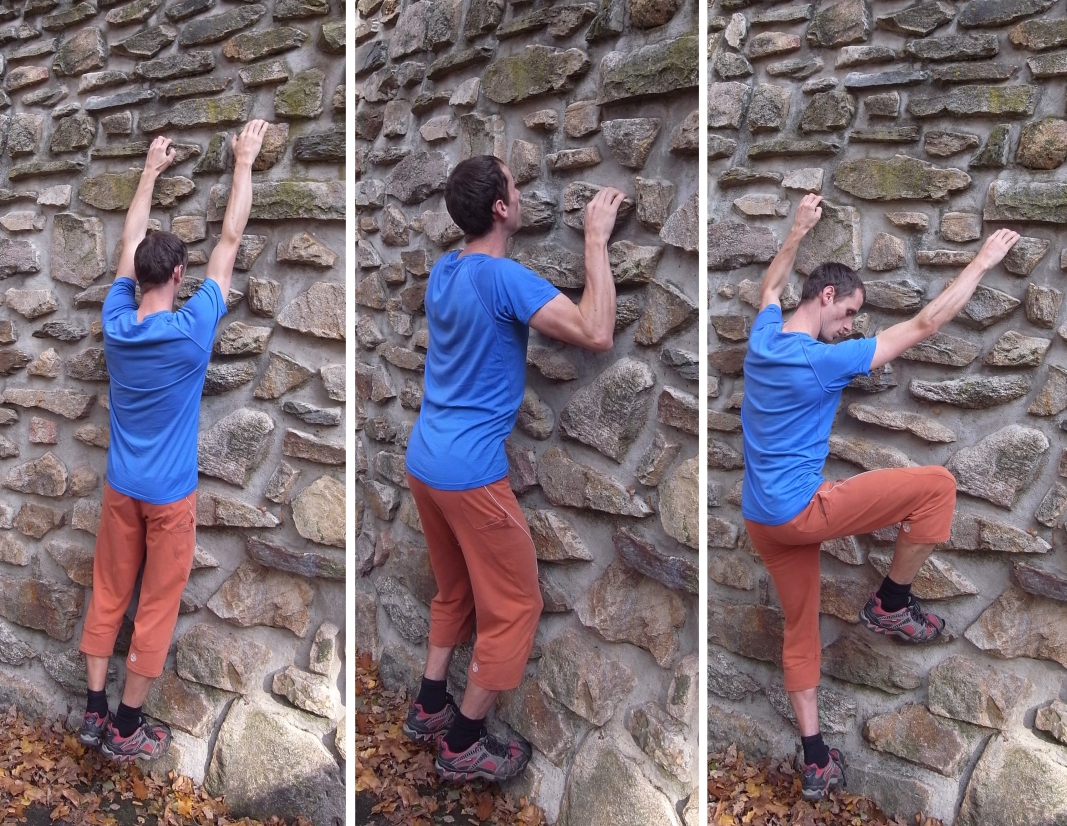
The extended position limits the view and next movement; the bended arms lead to a quick muscle fatigue; the optimal climbing position should enable movement to all directions and a good view
Exercise examples
On an artificial wall
-
Finding optimal position
During the optimal climbing position, arms are stretched and lower limbs position enable the pelvis movement to sides. The basic mistake of beginners is the too much stretched position and/or bended arms. The stretched position limits the view and further movement. Bended arms are the reason for fast fatigue of forearm muscles.
Blind climbing
A climber climbs with covered eyes. His/her partner helps by talking and saves him/her. The sense of this exercise is to understand the position and own body movements. The blind climber often stands on legs much better than when seeing.Group change
A group divides in two halves and each team stands on the opposite side of the wall. The task is to change positions while climbing from one side of the wall to the other and do not fall down.A pair climbing
A pair has hands or legs tied together with a scarf. The task is to overcome a certain distance without falling off the wall.
On boulders
-
Slab climbing
We stand on a sloping slab without holding with hands. We try to hold trunk upright, the centre of gravity is above the standing leg. When climbing a slab we hold the centre of gravity above the standing leg. The most often mistakes: trunk is too close to the rock, which lowers the climbing shoes friction, the upper limbs have to be used more and there is a possibility of slipping. We ascent on the sloping boulder without hands support. When moving up we transfer the body weight above the supporting leg from left to right and back
-
Overhang climbing
To climb an overhang is really a challenge for all climbers. The movement up is easier if we turn the hip which is opposite to the holding hand, to the wall. Climbing over the overhang edge is easier the higher you put feet under the edge). Using a knee can help when climbing over the overhang edge.
Travers
Traversing is climbing close above the ground to the side. We determine the first and the last hold, which have to be hold with both hands. When traversing we try to have arms stretched or slightly bended, the centre of gravity should be above the supporting leg at most. The most often mistake is if the arms movement is faster than legs movement. The body can be turned round
Jump
Jump to a faraway hold belongs visually to the most efficient climbing steps. The climber has to concentrate on a full take-off lower limbs and leaving the gripped hold at the latest. After the take-off the lower limbs should be stretched and upper limbs only slightly bended. Performing the jump with bended upper limbs usually limits the take-off. When reaching the target hold it is necessary to stabilize body fast and put feet on holds
| Spotting in bouldering demands full concentration, be ready with your hands at the shoulders' level | |
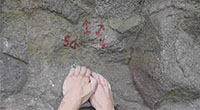 | |
| Some of the bouldrer problems are marked by arrows; the arrow designates the direction of a climb | |
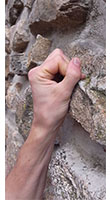 |
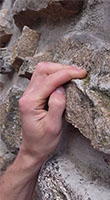 |
| Crimp and open grip | |
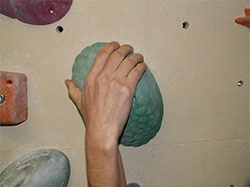 | |
| Slopers are holds that are grounded or that slope away from the rock | |
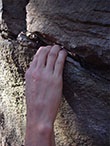 | 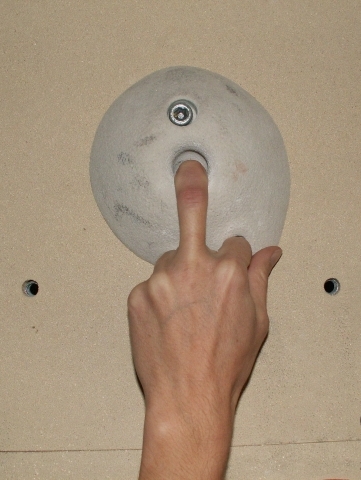 |
| The four-finger pocket minimizes the use of the thumb | The mono-pocket is associated with hard climbing |
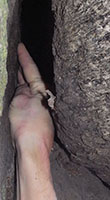 | 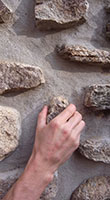 |
| Hand jam in a crack | Pinch grip is hard to hold even for advanced climbers |
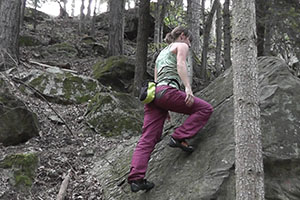 | |
| During slab climbing, the body mass is above the feet | |
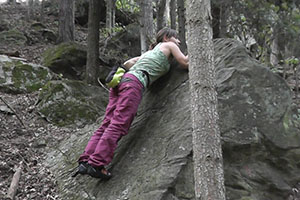 | |
| The common mistake during climbing is drawing the trunk close to the rock and pulling on arms | |
| When climbing over the overhang edge, put your feet as high as you can | |
| The use of knee can be advantageous when toping-up the overhang | |
| Traversing close above the ground is the most often bouldering activity | |
| A common mistake by traversing is when the arm movements go ahead of feet movements | |
| During jumping, the focus is on the top hold and on the take-off from the legs | |
